General Motors’ so-called “new-look” “fishbowl” buses were introduced in 1959 and almost immediately made a, er, splash on NYC streets, with selected routes getting them the very next year. The “fishbowl” moniker came from their large front windows, which bowed out and allowed a good look at the driver. The interiors were a departure from the upholstered seats from earlier GM and Mack buses, which were routinely attacked by vandals — the new seats were relatively thin green or pink molded plastic, which was also gaining increasing use in the subways.
The windows were round-edge parallelograms with rounded edges; to open them, which was a necessity in summer in pre-AC days, you pushed a button while simultaneously pushing the window, an operation I never quite got the hang of. At times, the bottoms of the windows would detach and the entire window set would flap when the bus made a turn!
These were the buses which, for the most part, carried whichever parent had the duty of taking me for my weekend bus ride I indulged in as a child. In Bay Ridge I had my pick of the B16 (Fort Hamilton Parkway to Prospect Park), B63 (5th Avenue to Brooklyn Heights), B64 (86th Street and Bath Avenue to Coney Island) B37 (3rd Avenue to downtown, where we would ususally wind up at A&S, now Macy’s). On rarer occasions we would take the B4 (Bay Ridge Parkway, or as every Bay Ridgeite calls it, 75th Street, to Gravesend); the B1 (Bay Ridge Avenue, or as every Bay Ridgeite calls it, 69th Street, to Sheepshead Bay). We would even assay the B35, which rolled to Ultima Thule, as far as we were concerned — East New York.
These buses also saw me through my high school days, where I could show a transit pass and get on for a nickel in the days when regular rides cost 35 cents and later, 50 cents. My college era, as well, at St. Francis College on Remsen Street; if I was in a rush, I would use the graffiti-and delay- ravaged RR train, which dropped an R in 1978, but if I wasn’t, I’d take the B63 or B37 fishbowls for a leisurely trip since both let me out near Remsen Street.
By the early 1980s the fishbowls were being phased out on NYC streets and GM stopped their production entirely in 1986. In NYC, there were three eras of Fishbowls — the first wave in the 1960s were painted green; beginning in the early 1970s, two shades of blue, and before the phaseout, white with a blue panel. Selected routes got lengthy panels on the top on both sides, which usually carried ads.
In 1973 a GM fishbowl on the M15 route idles at Park Row just northeast of Broadway, waiting to make an uptown run to East 126th Street on 1st Avenue; it will use 2nd Avenue for the southbound run. Just a couple of years earlier, its predecessor GM, waits at the same spot. In the 2nd photo, we see a pair of Westinghouse Whiteway lamppost luminaires, which dominated Water Street, Park Row, the Bowery, and 3rd and 9th Avenues in the 1960s and 1970s.
At the far left of the photos, according to New York Songlines, was Mathew Brady’s photo studio, opened in 1844, where Presidents Van Buren, Polk and Fillmore had their portraits taken. In the center is the Chapel of St. Paul, the oldest building in Manhattan, completed in 1766. In back of the church we see the twin World Trade Center towers, built between 1969 and 1974 and destroyed by terrorists in 2001.
Vintage photos on this page come from the collection of Larry Rogak and from NYC Subway.org. Modern day views are from Google Street View.
MTA transit historian Andrew Sparberg: The photo of #7075 , an old look GM, was actually built in 1957 and represents the next to last order of “old look” GMs that NYC Transit Authority purchased. The last such group was the 9000-9120 series, built in 1958, which were simiilar to the 209 in the 7000 series built the previous year. The 7000 series were noteworthy because they were the first NY buses to have the hard plastic seats and the push-type rear exit door, both of which became standard features afterward. The 9000s originally ran in the northern part of Brooklyn; the 7000s originally ran in Manhattan and Queens. Of course both found their way all over the city before retirement.
12th Avenue and West 43rd Street, in 1972 and 2009. Pretty much everything has changed. The M16 line no longer runs this far west, instead terminating at the Port Authority Bus depot at 9th Avenue and West 42nd, then running east on 34th Street, 2nd Avenue and East 23rd to the FDR Drive. The old West Side, or Miller Highway was taken out of service in late 1973 and demolished by the mid-1980s. The oddly bowed building, with three rows of windows on the upper floor, is now a United Parcel Service depot; I do not know what function it had in 1972.
This is the 2nd GM Fishbowl we’ve seen with a liquor ad bolted to the front.
In the mid-1970s, a B41 waits at Cadman Plaza West and Elizabeth Place to make a southeast run down Flatbush Avenue to either Kings Plaza or Bergen Beach. In the 1970s DUMBO was still an industrial neighborhood, dominated by manufacturing and warehouses, but that would all change beginning in the 1990s when many of the old manufacturing lofts would be converted to residences. The old fireboat dispatcher’s office would do time as a Fulton Ferry Museum and later, an ice cream parlor. Bargemusic has set up shop at the foot of Old Fulton Street, which Cadman Plaza West was renamed above the Brooklyn Bridge approach in the early 1980s. The Twin Towers, of course, dominated the Manhattan view until 9/11/01.
Broadway and West 49th, looking east, 1981. I daresay that when the building containing this Howard Johnson’s was demolished to make way for the present 1616 Broadway (see below) there wasn’t the weeping, gnashing of teeth, and rending of garments that accompained the closure of the Times Square area’s last HoJo at Broadway and West 46th in 2005. The Brass Rail Restaurant is long gone, but its bar, crafted in the 1880s, can be found at its Locust Valley, Long Island namesake. The M27 route still runs on West 49th-50th Streets from the Port Authority to the United Nations on 1st Avenue. The FM99 on the ad was then WXLO, a Top 40 station; today it’s WRKS “Kiss FM,” an urban contemporary format.
Andrew Sparberg: The photos on the B41 and M27 routes are not GM but Flxible (spelled correctly) fishbowl buses, similar looking but a different manufacturer. NYCTA ordered its first Flxibles in 1964 (for Brooklyn routes) and by the early 1980s newer Flxibles were used all over the five boroughs. Flxible was GM’s only major transit bus competitor in the 1960s and 1970s, but even its buses used GM engines and transmissions. GM went out of the transit bus business in the mid-1980s.
Today pretty much everything on Broadway and West 49th, as well as east on 49th, has changed. 1616-1626 Broadway now is home to Ruby Foo’s, although Colonie Records, directly opposite, was there in 1981 and is there today. Gray Line double decker sightseeing buses are a frequent sight in Midtown and elsewhere, year round.
In 1981, a blue GM fishbowl, the Q56 (then called the B56) idles at the NE corner of Jamaica Avenue and Parsons Boulevard. Then as now, the Q56 is basically the western Jamaica Avenue local, running from the Broadway subway junction at Fulton Street and Broadway (you have your pick of the A, C, J and L trains there) east to 170th Street. Note the old el pillars: the BMT Jamiaca Avenue el which ran out to 168th Street ended service in 1978, and the city rather leisurely demolished the line. The pillars seem to be sporting a 1976 Bicentennial red, white and blue paint scheme. The el was rerouted in a new el and tunnel connection to the Parsons Blvd./Archer Avenue station, with a transfer to the IND E train, in 1988.
Fast food now dominates the corner, with Wendys where Goodyear (Tires?) was, and the golden arches on the opposite corner. The other side of Jamaica Avenue has changed the most since 1981, with a new multiplex theatre, Parsons/Archer subway entrance, and York College branch.
Bartel-Pritchard Square, early 1970s, Prospect Park West and 15th Street, where the Sanders Theatre is double featuring the late great Bruce Lee in the classic Enter The Dragon and another go-round for Christopher Lee as the blood-seeking Count in Dracula AD 1972. The Sanders has a lengthy history, having opened in 1908 as the Marathon Theatre, dismantled in 1928 and rebuilt as the Sanders. Soon after this photo was taken the Sanders entered a lengthy period of moribundity, reopening as the multiplex Pavilion in the mid-1990s.
In the 1970s the Transit Authority operated the B88, a “Culture Loop” which ran in downtown Brooklyn between sites such as the Brooklyn Academy of Music, Long Island University, the Brooklyn Public Library, and other sites. Manhattan had its own Culture Loop route, the M41.
Not a great deal has changed in nearly 40 years. The corner site is still a restaurant, and the Pavilion has shoehorned 10 screens into the Sanders’ old one-screen space.
What is likely the B64 (Bay Ridge to Coney Island) crosses the Stillwell Avenue truss bridge over Coney Island Creek in 1981. Soon everything in this photo will be swept away; the Fishbowls will be history; the city will replace the modest truss bridge with a much more boring item, and all the trees and weeds will be gone. The B64 has had two routes to Coney Island, depending on the caprices of the MTA: it either uses the Cropsey Avenue bridge (which retains its 1930s span) or Stillwell Avenue, which I believe it is favoring at present (2010). Photo courtesy Bernard Ente collection
2009, same scene, less rural and more yawn-inducing. For some reason the Google Earth photo truck chose the rainiest, gloomiest day possible to shoot the streets of Coney Island ….
Page completed March 15, 2010.

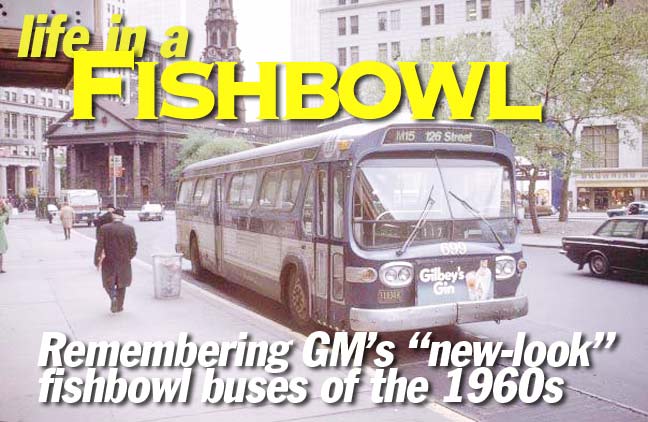

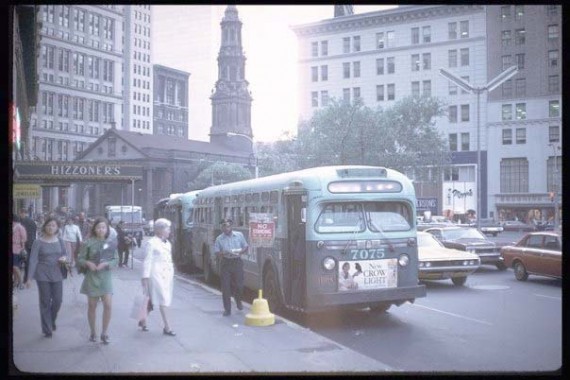





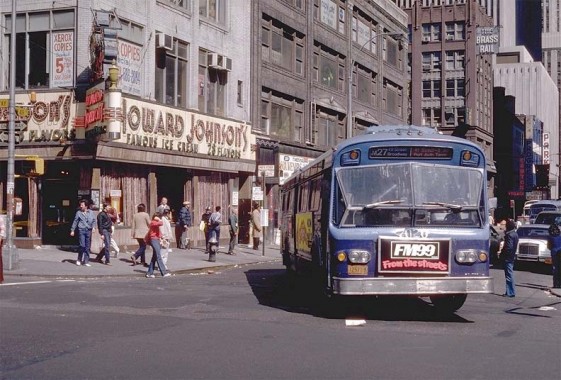

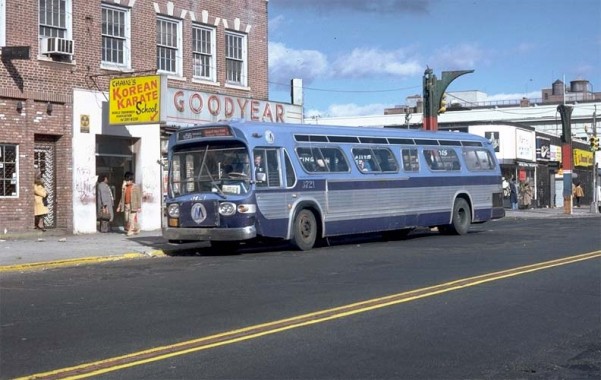




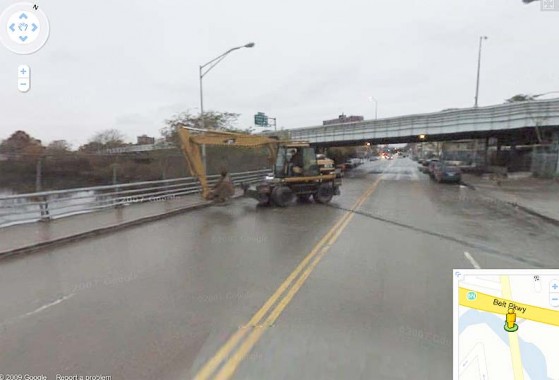
5 comments
interesting to see the contrasts in time. those blue buses were real bland- much like the city in the 60s- 80’s. Still in all, better than the 90’s- present day yuppie era
Of the ‘Fishbowls’ (whether GM or Flxible), the thrill for me was the back of the buses, whose windows were laid out either in three or four panels. My preference was toward the four-panel back window arrangement. (The center in that arrangement told me where the center was.)
This was a nice walk down memory lane for me as these were the buses I remember riding from my childhood as well. They wore several paint schemes from an original dark green to the blue/navy you show here, to a white/navy and finally a white/TA blue scheme.
Many of the GM units were rebuilt towards the end of their service lives and retrofitted with forward-facing seats and (much welcomed) air conditioning. The Flxibles just sort of faded away at least in my memory. Grumman-Flxible offered a new technology replacement in the early 1980s, but structural problems led to their withdrawal from service.
Despite the rebuild, the GM New Looks’ days were numbered, as these buses were inaccessible to those in wheelchairs. A more accessible transit system is better for everyone, but I appreciated the walk down memory lane.
I also thought I’d point out one correction to your narrative. The RR did indeed drop an ‘R,’ as you put it, but it wasn’t until a bit later. Double letters (to differentiate local from express services) remained a feature of the subway (at least on the IND and BMT or ‘B Division’ lines) until 1985, when they were eliminated in an attempt to make the system easier to navigate (particularly for visitors, I suppose.) Thus, the AA and CC of my kindergarten days were eliminated in favor of the K and the C trains as I entered first grade.
The fifth and sixth photos are not GM New Look “Fishbowls”. They were manufactured by the Flxible Corp., GM’s largest rival at the time.
The sixth and eighth photos are not GM New Look “Fishbowls”. The ones in those photos were manufactured by the Flxible Corp., GM’s largest rival at the time.